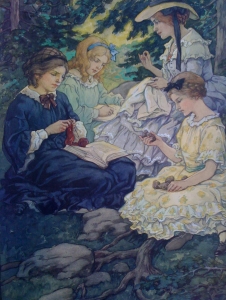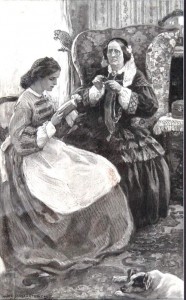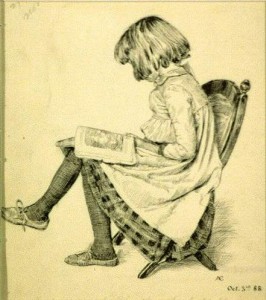 Rosina Emmet Sherwood (1854-1948)
Rosina Emmet Sherwood (1854-1948)
Disgusted with life, she retired to the society of books, (October 3rd) 1888
Story illustration for “The A.O.I.B.R.” by Elizabeth Eggleston Seelye in Harper’s Young People, 10 (April 16, 1889): 412.
Ink on paper
The Library of Congress, Cabinet of American Illustration, CAI – Sherwood, no. 21 (A size)
We read for lots of reasons: for pleasure, leisure, learning, and to treasure. Why does it matter that artists picture women and girls reading? Because it is a relatively modern phenomena. How many times can you remember seeing an artist representing a woman reading? Until the mid 19th-century, not often at all. If you try to put the concept of imaging women reading into some historical context, it is not really until Louisa May Alcott (1832-1888) wrote Little Women (first published in 1868) that a primary fictional woman character was noted for her habit of reading and writing.
Clara Miller Burd (1873-1933) AliceBarber Stephens (1858-1932)
The Sisters Sat Together in the Shady Nook Reading to Aunt March
Frontispiece illustration for Louisa M. Alcott’s Illustration for Louisa May Alcott’s Little Women
Little Women (Chicago: The John C. Winston (New York: Collier’s, 1911)
Co., 1926) Collection of Robert and Lynne Horvath
Eisenstat Collection of American Illustration
The character of Jo March is an example of what I call a ‘plucky girl’ type that became popular in the wake of Alcott’s publication of her most influential story. When American literature shifted in the second half of the 19th century, stories of boys and girls mutated. Characterizations of children moved from moralizing tales and their descriptions of insipid, but right-thinking children to stories about active individualistic self-possessed, and even sometimes, flawed children. Plucky girl characters provided role models for a new era of self-determined individuals including girls, who read both for pleasure and to be informed. (Brazen boys is the description I use for the male version of the plucky girl.)
Clara Miller Burd’s image of Jo March reading (seen above left) is shown sitting with her sisters out of doors as they typically pursue some womanly activity: knitting, sewing, and sketching. Burd distinguishes Jo from her less adventurous sisters by showing her with her hair tumbling out of her hair-net while her sisters all look neat and decorous. Jo also is shown wearing a dark navy colored dress, meant to help hide ink spots from her writing, while her sisters all wear pastel colors. In Alice Barber Stephens’ illustration (above right) of Jo reading aloud to her Aunt March, Stephens’ version of Jo seems to be dressed perfectly respectably, but the girl’s face indicates a bit a mischievousness. While intent on the story being told, Aunt March’s countenance shows just a hint of disapproval for her forward niece.
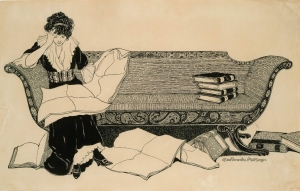 Gertrude A. Kay (1884-1939)
Gertrude A. Kay (1884-1939)
Untitled Tailpiece, c.1913-14
Ink on illustration board
DAM, Gayle and Alene Hoskins Endowment Fund, 1988, 1988-142
Soon American stories and illustrations of girls and women reading would become commonplace. The above Gertrude Kay ink drawing created as a story tailpiece always makes me smile. I love the clutter of books and papers littering the space around her, proving that a pretty girl may also be curious and well-read. Don’t overlook the elegant patterns that mark the wood trim of the sofa on which she sits.
The Rosina Emmet Sherwood* illustration at the beginning of this posting was commissioned to accompany an 1889 story by Elizabeth Eggleston Seelye published in an issue of Harper’s Young People about Janie Buckminster, a little girl, who when she grew disgusted with the social life around her, retreated to the society of books.**
One of my favorite finds of an illustration of women reading was a turn of the century poster produced by the publisher Harper’s. The title of this poster, The Best for Family Reading, is reflected in another Rosina Emmet Sherwood image. Each family member reads one of the Harper’s family of magazines from the serious in-depth coverage of the Monthly (seen in the mother’s hands) to the Round Table meant for the younger members of the family (seen in the son’s hand).
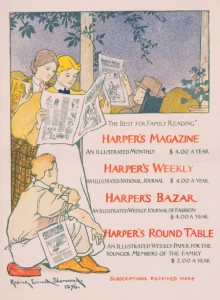
Rosina Emmet Sherwood (1854-1948)
The Best for Family Reading, 1896
Poster illustration for Harper’s periodicals
If you’ve reached this conclusion, you already know that reading can inform, educate, and entertain. Imaging woman as a normal part of the reading public was just one more way to see that women’s roles in American life began their shift earlier in the 19th-century than we commonly believe.
* Mrs. Sherwood was from a family of women painters including her sisters, Lydia Emmet and Jane Emmet De Glehn and a cousin to Ellen Emmet Rand.
** “The A. O. I. B. R.” of the story’s title refers to her private girls society (The Association of Independent Bell-Ringers) that harassed their neighbors by pulling on their door bells and then running away to hide. Charming wasn’t she.
February 7, 2013
By Joyce K. Schiller, Curator, Rockwell Center for American Visual Studies, Norman Rockwell Museum


